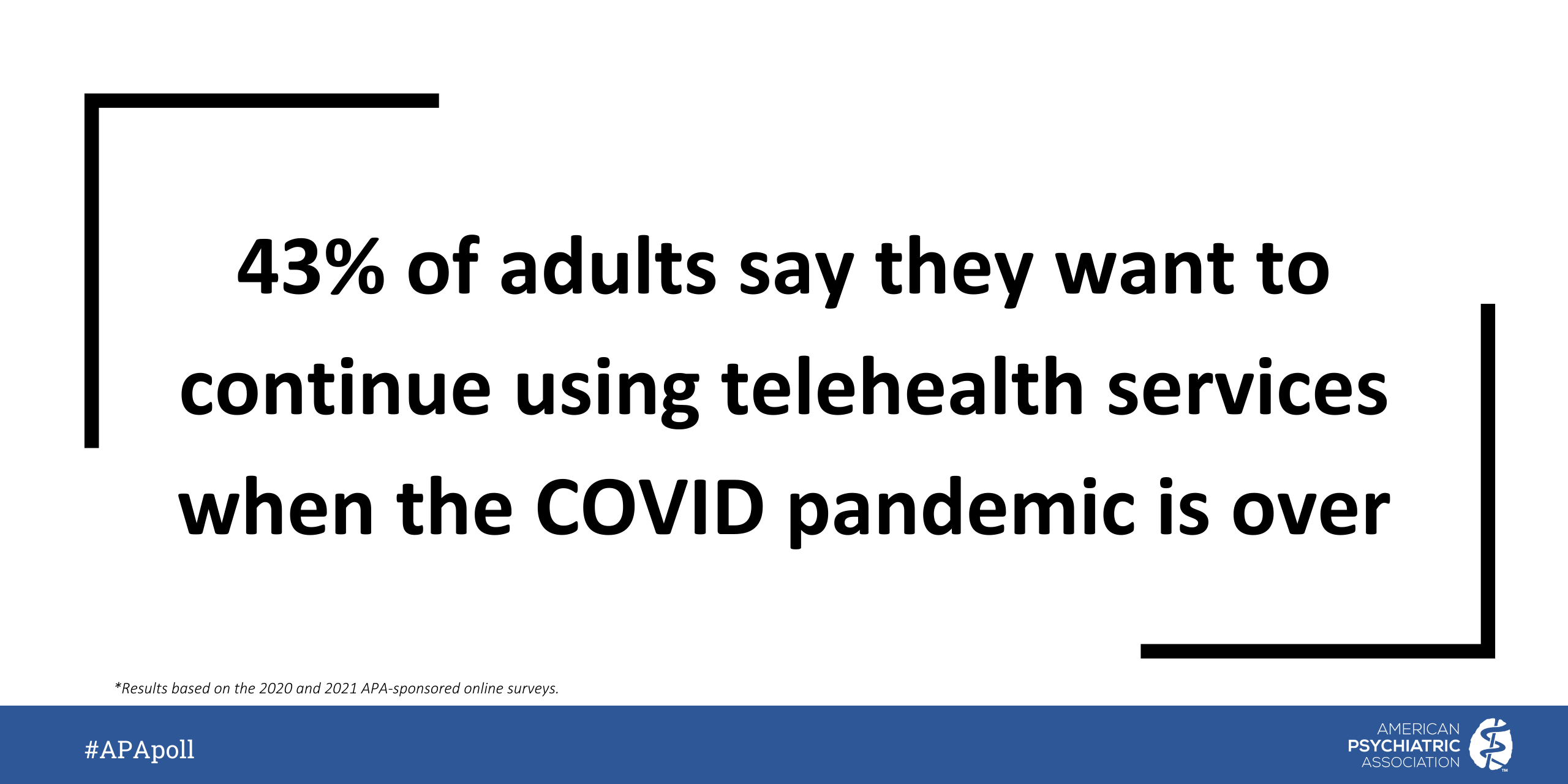New Nationwide Poll Shows an Increased Popularity for Telehealth Services
Washington, D.C. – A new national public opinion poll of U.S. adults by the American Psychiatric Association (APA), finds that expansion of telehealth is welcomed by most Americans. A large portion of the population have used telehealth services; more than half say they would use telehealth for mental health services; and more than one in three say they prefer telehealth.
- Nearly four in ten Americans (38%) have used telehealth services to meet with a medical or mental health professional, up from 31% in the fall of 2020. Among those using telehealth services, the vast majority have used the services since the start of the pandemic (82%). Most survey respondents are using telehealth through a video format (69%), while 38% have used phone calls only.
- Though telehealth services have become widely used during the pandemic, according to the survey, difficulties scheduling mental health appointments has been a problem for many Americans. One in three survey respondents who have sought to make an appointment for mental health services say they had difficulty scheduling an appointment in the past several years. African Americans and Hispanics were more likely than whites to have had difficulty, and younger adults were more likely than older adults to have had trouble scheduling an appointment.
“The quick pivot to providing telehealth services at the start of the pandemic was vital to providing continued access to care, and this poll shows the important potential role for telehealth going forward,” said APA President Vivian Pender, M.D. “Telepsychiatry especially helps those facing barriers such as lack of transportation, the inability to take time off work for appointments, or family responsibilities.”
“Continued access to telehealth during and after the pandemic is vital, and the poll indicates increasing public support for it,” said APA CEO and Medical Director Saul Levin, M.D., M.P.A. “As we continue to face the long tail of the pandemic, we have an opportunity to innovate and continue to improve access through telehealth.”
Other findings:

- Perception of the quality of telehealth services has improved over the last year. Survey respondents are slightly more likely this year than last to say that telehealth services can offer the same quality care as in-person services (45% up from 40%).
- The percentage of Americans saying they would use telehealth services for mental healthcare increased from 49% in 2020 to 59% in 2021. Younger adults were more likely to say they would use telehealth for mental health services (66% of 18-29-year-olds) compared to older adults (36% of those 65 and older). Similar percentages of Blacks, Hispanics and whites said they would use telehealth services for mental healthcare (between 58% and 61% each).

- 43% of adults surveyed say they want to continue using telehealth services when the pandemic is over. More than one in three adults (34%) say they would prefer telehealth service to an in-person doctor’s office visit, up from 31% in 2020. Among younger adults, ages 18 to 44, 45% would prefer telehealth service to in-person visits.
- A majority of Americans surveyed say they are receptive to using a support line or an online chat during a time of personal difficulty and mental anxiety. This refers to use of a confidential, free service offering conversation, emotional support and information before a crisis develops. Fifty-seven percent would consider using a support line or online chat––in addition to the 7% who have already used one. Only 21% say they would not consider using one.
More on the poll:
See the full results of the poll. The new findings come from an APA-sponsored online survey conducted March 26 - April 5, 2021, among a representative sample of 1,000 adults 18 years of age and older. The equivalent margin of error is +/-3.1 percentage points. Additional polling information available: more from the 2021 polling and information from polls in October 2020 and prior years.
American Psychiatric Association
The American Psychiatric Association, founded in 1844, is the oldest medical association in the country. The APA is also the largest psychiatric association in the world with more than 37,400 physician members specializing in the diagnosis, treatment, prevention and research of mental illnesses. APA’s vision is to ensure access to quality psychiatric diagnosis and treatment. For more information please visit www.psychiatry.org.
